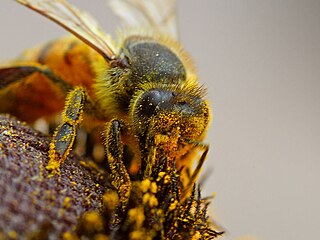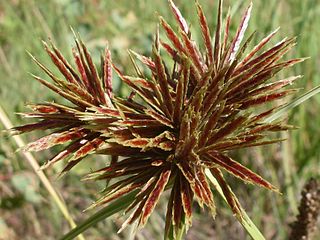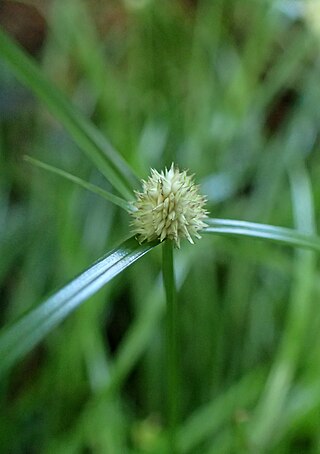
Cyperus papyrus, better known by the common names papyrus, papyrus sedge, paper reed, Indian matting plant, or Nile grass, is a species of aquatic flowering plant belonging to the sedge family Cyperaceae. It is a tender herbaceous perennial, native to Africa, and forms tall stands of reed-like swamp vegetation in shallow water.

The Cyperaceae are a family of graminoid (grass-like), monocotyledonous flowering plants known as sedges. The family is large: botanists have described some 5,500 known species in about 90 genera, the largest being the "true sedges" with over 2,000 species.

Cyperus is a large genus of about 700 species of sedges, distributed throughout all continents in both tropical and temperate regions.

Cyperus esculentus is a species of plant in the sedge family widespread across much of the world. It is found in most of the Eastern Hemisphere, including Southern Europe, Africa and Madagascar, as well as the Middle East and the Indian subcontinent. C. esculentus is cultivated for its edible tubers, called earth almonds or tiger nuts, as a snack food and for the preparation of horchata de chufa, a sweet, milk-like beverage.

Entomophily or insect pollination is a form of pollination whereby pollen of plants, especially but not only of flowering plants, is distributed by insects. Flowers pollinated by insects typically advertise themselves with bright colours, sometimes with conspicuous patterns leading to rewards of pollen and nectar; they may also have an attractive scent which in some cases mimics insect pheromones. Insect pollinators such as bees have adaptations for their role, such as lapping or sucking mouthparts to take in nectar, and in some species also pollen baskets on their hind legs. This required the coevolution of insects and flowering plants in the development of pollination behaviour by the insects and pollination mechanisms by the flowers, benefiting both groups. Both the size and the density of a population are known to affect pollination and subsequent reproductive performance.

Cyperus bulbosus is a species of sedge found across Africa, the Middle East, Indian subcontinent, Southeast Asia, and Australia. In Australia, it is commonly called Nalgoo or (Australian) bush onion or "wild onion", but is not related to the onion or other Alliaceae. It is a component of Australian bushfood, but is considered an agricultural weed in other areas.

Rhynchospora alba, the white beak-sedge, is a plant in the sedge family, Cyperaceae. It is a tufted herbaceous perennial around 50 cm tall, with white inflorescences that flower in August. The fruit of the sedge is a small achene with a characteristic beak-like cap. It is dispersed by wind or falls by gravity, leading to individuals existing in tight clumps. The species favours wet, acidic and nutrient poor soils, thriving in Sphagnum-dominated bogs, but also peaty grasslands. As such, it is often used as a positive indicator for bog and mire ecosystem health.

Cyperus congestus, commonly known as dense flat-sedge or clustered flat-sedge, is a sedge of the family Cyperaceae that is native to southern Africa mostly in South Africa, Lesotho and Namibia.
Cyperus prolixus is a species of sedge that is native to southern parts of North America, Central America and tropical parts of South America. It is a perennial plant that grows up to 2 meters tall. The leaves are long and narrow, and the flowers are small and white. Cyperus prolixus is found in a variety of habitats, including wetlands, meadows, and roadsides. It is a common plant and is not considered to be threatened or endangered.
Cyperus amabilis, commonly known as the foothill flatsedge, is a species of sedge that is native to tropical and sub-tropical areas in the Americas, Africa and Asia.

Cyperus cephalotes is a species of sedge that is native to tropical areas in Asia and Australia.
Cyperus crassipes is a species of sedge that is native to parts of Africa.
Cyperus croceus, commonly known as Baldwin's flatsedge, is a species of sedge that is native to parts of North America, Central America, and South America.
Cyperus margaritaceus is a species of sedge that is native to parts of Africa.
Cyperus thunbergii is a species of sedge that is native to the Cape Provinces of South Africa.
Cyperus pilosus is a species of sedge that is native to parts of Asia and Australia.
Cyperus pustulatus is a species of sedge that is native to tropical parts of Africa.
Cyperus reflexus is a species of sedge that is native to parts of the Americas.
Cyperus eglobosus is a species of sedge that is native to Queensland and New South Wales in eastern Australia.
Cyperus pectinatus is a species of sedge that is native to much of Africa.









